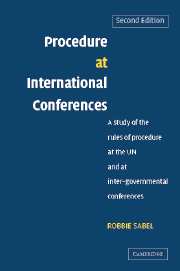 Procedure at International Conferences
Procedure at International Conferences Book contents
- Frontmatter
- Contents
- Preface to the second edition
- List of abbreviations and conference references
- Introduction
- 1 Historical development of rules of procedure of conferences and attempts to establish model rules
- 2 Adoption of rules of procedure
- 3 Rules of procedure and international law
- 4 Invitations, participation and credentials
- 5 Presiding officer and other officers of the conference
- 6 Meetings
- 7 Statements by delegations
- 8 Submission of proposals
- 9 Adjournment and closure of debate
- 10 Amendments
- 11 Withdrawal and reconsideration of motions
- 12 Procedural motions and points of order
- 13 Priorities between different proposals
- 14 Decision taking and method of voting
- 15 Majority required
- 16 Consensus
- 17 Separate votes
- 18 Conduct of voting – interruption of voting and correction of vote
- 19 Languages, records and documents
- 20 Committees
- 21 Suspension and amendment of rules of procedure
- Bibliography
- Index
9 - Adjournment and closure of debate
Published online by Cambridge University Press: 22 July 2009
- Frontmatter
- Contents
- Preface to the second edition
- List of abbreviations and conference references
- Introduction
- 1 Historical development of rules of procedure of conferences and attempts to establish model rules
- 2 Adoption of rules of procedure
- 3 Rules of procedure and international law
- 4 Invitations, participation and credentials
- 5 Presiding officer and other officers of the conference
- 6 Meetings
- 7 Statements by delegations
- 8 Submission of proposals
- 9 Adjournment and closure of debate
- 10 Amendments
- 11 Withdrawal and reconsideration of motions
- 12 Procedural motions and points of order
- 13 Priorities between different proposals
- 14 Decision taking and method of voting
- 15 Majority required
- 16 Consensus
- 17 Separate votes
- 18 Conduct of voting – interruption of voting and correction of vote
- 19 Languages, records and documents
- 20 Committees
- 21 Suspension and amendment of rules of procedure
- Bibliography
- Index
Summary
Adjournment of debate
The UNGA rules of procedure state:
Rule 74
Adjournment of debate
During the discussion of any matter, a representative may move the adjournment of the debate on the item under discussion. In addition to the proposer of the motion, two representatives may speak in favour of, and two against, the motion, after which the motion shall be immediately put to the vote. The President may limit the time to be allowed to speakers under this rule.
The UN Model Rules propose:
Rule 41
Adjournment of debate
A representative may at any time move the adjournment of the debate on the question under discussion. Permission to speak on the motion shall be accorded only to two representatives in favour of and to two opposing the adjournment, after which the motion shall, subject to rule 44 [Rule 44 deals with priority of motions], be immediately put to the vote.
Effect of adjourning the debate
Motions to adjourn the debate are normally adopted sine die, that is without deciding on a time for renewal, and such motions result in the termination of discussion and the prevention of voting on the issue concerned. A motion to adjourn the debate differs from a motion to close the debate in that a motion to ‘close’ terminates discussion and authorises the meeting to proceed immediately to a vote. A motion to adjourn prevents both debate and voting.
- Type
- Chapter
- Information
- Procedure at International ConferencesA Study of the Rules of Procedure at the UN and at Inter-governmental Conferences, pp. 177 - 200Publisher: Cambridge University PressPrint publication year: 2006


